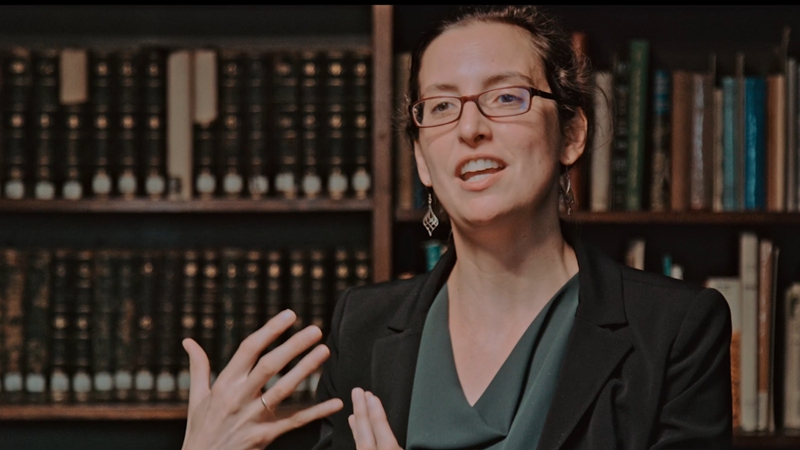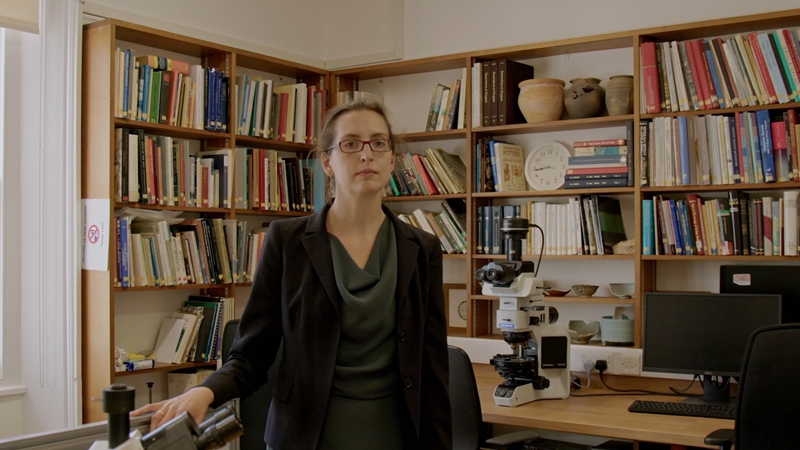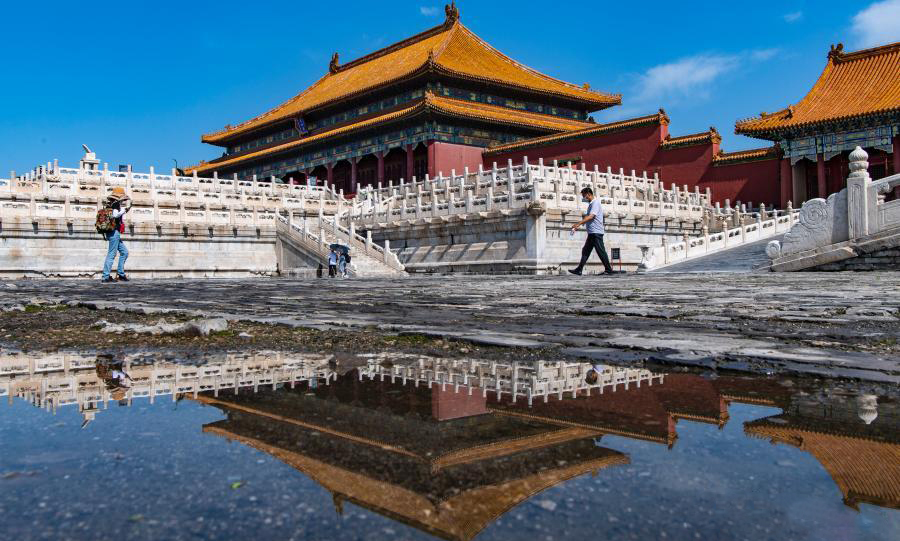Anke Hein: Diversity is beauty and strength
Dr. Anke Hein is Peter Moores Associate Professor in Chinese Archaeology at the University of Oxford. Employing a wide range of research methods, from petrography to ethnography, her research focuses on the cultural contact and identity formation of early human societies, primarily with a focus on present-day western China.
Since 2006, Hein has participated in numerous excavations and surveys along the eastern rim of the Tibetan Plateau, stretching from the Hexi Corridor in Gansu all the way south to the mountainous region of central Sichuan. Her book on prehistoric burials in the Liangshan region is one of the first English publications dedicated to the area.
As president of the Society of East Asian Archaeology and principal investigator of multiple international projects, Hein plays an instrumental role in promoting cultural exchange and academic collaboration between China and the rest of the world.

Anke Hein (Photo/Fraser Watson)
To learn something new through something old
People’s Daily Online: Some 15 years after your first visit to China, you became the Peter Moores Associate Professor in Chinese Archaeology at the University of Oxford. Looking back, what was it that initially drove your interest in Chinese archaeology?
Hein: Originally, when I started my studies at university, I wasn’t really sure what I wanted to do. So I decided to do something I knew nothing about but is very promising and started studying Chinese language and culture. After my first year of studies at the University of Heidelberg in Germany, I had the chance to go to China for a year.
When I arrived, everything seemed different, big, new and very vibrant. What I found especially fascinating was that no matter who I talked to, they would ask me: “Did you know that China has 5,000 years of history?” I became very aware that in China the past is incredibly present, and it’s important to people’s identity and everyday life.
When I was doing my studies, I was slightly frustrated that sinology, or Chinese studies, is all about historical texts. It’s all about the words written by the powerful, the top 1 percent of society who dominate what we know about the past in China. That is how I had the idea to maybe study archaeology because the research of material culture gives us the opportunity to gain insights into the everyday life of mundane people.
Archaeology is incredibly powerful in giving a voice to people who don’t have a voice in historical records.
People’s Daily Online: And so, how did you continue to further your studies in the subject?
Hein: During my studies, a major problem was that Germany didn’t have many places where you could study the archaeology of China. So, I studied what was called “classical sinology” – the history, language, and culture of China up to the Opium War – and combined it with East Asian art history and European prehistory.
I was reading literature on Chinese archaeology and came across the name Lothar von Falkenhausen. Although I was initially quite intimidated about writing directly to him, I eventually did and he replied in a long email with a lot of advice on what I needed to do to study Chinese archaeology. He advised me to go to Peking University and spend a year there as a visiting student if possible. He had never met me in person but was incredibly generous to say I was allowed to use his name when going to PKU.
Through Prof. Lin Meicun’s introduction, Prof. Sun Hua – an expert in the archaeology of southwest China – became my supervisor at PKU and he did so in an amazing manner. Between 2006 and 2007, whenever there was a break, he sent me on the road to visit excavations and I also participated in fieldwork for a couple of months. This student-teacher relationship never goes away and it’s very different from the supervision system in the European context.

Anke Hein (Photo/Fraser Watson)
Working with locals
People’s Daily Online: The living and working conditions at excavation sites are often quite rudimentary, and it might not be easy to dig in China as a foreign woman. Could you share with us some reflections on your fieldwork experience?
Hein: There were three excavations that I went to. One of them was in connection with the Three Gorges Dam construction project, during which we dug a Tang Dynasty burial. Although we didn’t get very far, it was interesting to see how such a big project could work and what the challenges might be.
Another place where I spent a lot more time under somewhat harsh conditions was Wucheng in Jiangxi Province, an important site that had a connection with both southern China and the central plains. Besides the wonderful archaeology, I was learning more about how people lived there and how they see their own heritage. It’s not just about what anybody in any capital or county’s capital decides. We archaeologists have to work with locals as it is their history, their area, and their soil. They have the local knowledge and manpower to help us actually do these excavations.
The third excavation that I participated in was an excavation at the site of Jinsha in Sichuan. It's connected to Sanxingdui – a site that most people probably know by now. But even people who maybe don't know the name of the site have seen one of its objects; and that is the gold disk with the sun and the birds around it. I find it incredibly interesting that the disk has come to symbolize cultural heritage management and archaeology in China even before the discovery at Sanxingdui. Through both Mr. Jiang Zhenghua of the Chengdu Institute of Cultural Relics and Archaeology and Prof. Sun Hua, I was connected to people in the Liangshan region where I ended up doing my dissertation work and some of my future fieldwork.
When I was excavating in Wucheng, Jiangxi, I was the only woman in the excavation. I felt a little bit isolated as they had to be a bit more careful about certain things because I am a foreigner. Another issue was that people would sometimes question if I understood anything about China. Overall, I think women do very well in the field. Maybe we can’t lift as much as the bulkier men but being able to suffer hardship is not something that women can do less.
People’s Daily Online: Over the past two decades, you have participated in numerous excavations in southwest China and completed your first book on the prehistoric burials of the Liangshan region. What’s so special about southwest China that appeals to you?
Hein: I work with many sites of different periods in different regions, but I have had my start in southwest China and that will always have a special place in my heart.
In terms of the work that I’ve been doing there, I’ve been mostly interested in the marginal and marginalised. The topic of a big civilization is all fine and interesting. But what is happening outside of these? And there I find southwest China to be a particularly fruitful region to look at because of its great ethnic and biodiversity.
There are high mountains, wonderful river valleys, high-altitude plateaus and the Chengdu Plain, allowing many different ways of living and subsistence practices. This actually applies to the whole eastern side of the Tibetan plateau and beyond, the whole area that runs from Gansu all the way down to Yunnan really into Southeast Asia.
People’s Daily Online: And what’s your next plan for the area?
Hein: As like everybody, I’m involved in several projects, most of which are unfortunately on hold because of the pandemic. The biggest one probably is the project in the Jiuzhaigou National Park in Sichuan. We are working with geologists, specialists in isotopic analysis and the Sichuan Provincial Institute of Cultural Relics and Archaeology to conduct an interdisciplinary study on climate change and human adaptation in a marginal environment.
The first step we took was to conduct a survey to look at various sites in high-altitude mountain regions of Sichuan where we found that people have been living at much higher altitudes than previously thought. People have lived there and were connected to areas north further north and further south very early on already during the Neolithic Period.

Anke Hein (Photo/Fraser Watson)
To understand a living past
People’s Daily Online: Archaeology in China has experienced rapid development since the end of the 20th century and has formed its own school of thought. What’s your opinion on the differences in the ways of doing archaeology between China and the rest of the world?
Hein: So, a lot of people who look at Chinese archaeology will wonder about it. They see all the differences; see things that are done differently. But the problem with that is the point of view is oftentimes one that sees the Anglo-American way of doing things as the standard. They see that things are done differently in China, marvel at it, often criticize it, but don’t really understand it.
That has partially to do with the domination of the Anglo-American ways of doing archaeology across the globe – which is very much based on theories and models – but also with a lack of knowledge of the Chinese literature. Most foreign scholars, especially those who don’t work specifically in China, will either only look at papers in English or eye-catching discoveries. They will not look at broader discussions on archaeological methods, theories, and processes. And they see them as not happening.
In reality, most countries around the world do archaeology more similarly to China, meaning great attention to detail, meticulous excavations, typology-based chronologies, and trying to establish local, chronological and cultural developments – essentially a cultural history.
First, you need to understand what happened. The most important things are the chronology, the materials, and the facts. If there's no facts, if there's no material, if there's no proof, if there's no way of proving it, it's not of interest.
People’s Daily Online: You mentioned that, in 2001, you chose to focus your studies on China because you wanted to learn something new. What motivates you to continue pursuing your studies on China today?
Hein: China is so incredibly diverse and that is a beauty and a strength. That is where China is maybe special. It is such a big country, such a diverse country, but it also has a continuous recorded history over a very, very long period.
It’s not like it isn't special. It very much is. It is also very much special to me. It is also, you could say it is, special in how much funding and efforts are invested into the study of the past. That's something that other countries could learn from quite a bit rather than cutting down funding on culture more and more. It's also special in the sense of like that the past is so present in everyday life and in today.
Photos
Related Stories
Copyright © 2022 People's Daily Online. All Rights Reserved.









